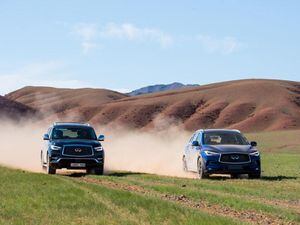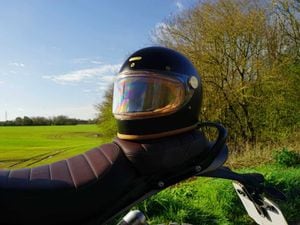To Infiniti and beyond: Fossil hunting in the Gobi desert
We head out to the fossil-filled Mongolian Gobi to see how Infiniti’s SUV lineup handles itself in the gruelling terrain

The recipe for the perfect Mongolian car is an odd one. Take one Toyota Prius, used, from Japan. Add tough offroad tyres, jack up the suspension with heavy duty springs and apply some insanely opaque window tints. Add on an owner’s club sticker and voila! You blend in with a good 50 per cent of traffic within the capital city of Ulaanbaatar.
Outside of the city though, it’s off-road vehicles that reign supreme. Only 20 per cent of Mongolia’s 31,000 miles of road are paved, the rest bare dirt tracks trodden mainly by Toyota Land Cruisers. So we didn’t feel too out of place when we were collected from the airport at the small town of Dalanzadgad in a pair of absolute monsters – Infiniti QX80s.
We’d come out to Mongolia to drive three of the brand’s SUVs, including the QX80, to celebrate a daring expedition conducted by American explorer Roy Chapman Andrews in the early 1920s – the first such trip to use the motorcar in a bid to travel further afield than they would otherwise.
Andrews’ expedition breached the Mongolian Gobi on a gruelling 1,000 mile route, and would eventually see him discover the first fossilised dinosaur eggs at the Flaming Cliffs – proving beyond all doubt that dinosaurs were reptilian creatures.

The Infiniti SUVs replaced Andrews’ fleet of Dodge Bros. cars in the modern expedition and, in conjunction with the Explorer’s Club of Hong Kong and the Mongolian Institute of Paleontology and Geology, had been finding new fossil sites using advanced drone mapping and LiDAR technology. Seriously impressive stuff.
The first leg of our journey took us from Dalanzadgad airport to our base for the trip – the Three Camel Lodge. We took the wheel of the QX80 and fell into convoy behind one of the lodge’s own Land Cruisers, unable to shake the sensation that the dirt roads were a rally special stage.

We managed through, and an hour of sensible (ish) driving later saw us arrive at the Three Camel Lodge. It’s a remarkable place – set up by American-born businessman Jalsa Urubshurow as the ultimate in sustainably luxurious accommodation for the discerning Western traveller. We’d stay in traditionally-built Mongolian gers – layered circular tents similar to yurts – with all electricity provided by solar panels and water recycled wherever possible.
We parked up the QX80s and got a look at the full range of SUVs for the first time – the QX50, QX60 and QX80. These cars had all been here for several weeks already and were certainly showing the effects of hard driving on unpaved roads – a few cracked windscreens and displaced panels gave an indication of the harsh conditions they’d been through.
Lunched and watered, we then slid back into the cars for a drive to our next stop – the Flaming Cliffs, the site of some of the most important fossil discoveries of the 20th century. The going was a little more treacherous, with horrific washboard surfaces rattling every fixture of the QX60 we’d chosen for this leg. We don’t get the ’60 in the UK, and that’s probably a good thing – it feels old-fashioned, with a confusing mess of Nissan parts on the inside and a thirsty, noisy 3.5-litre V6 engine under the hood. It was our least favourite of the three cars.
The journey passed without incident, though, and we soon arrived at the incredible vista of the Flaming Cliffs. Here, we would begin hunting for fossils under the watchful eye of fossil specialist Zorigt Badamkhatan – or Badmaa to us.
The team explained what we were looking for. Dinosaur bones would stand out white against the red soil, and Badmaa taught us an easy trick to figure out which are legitimate and which are just pretty rocks. “Lick your finger and press it against the bone,” he said. “They’re so dry and have so few minerals that they stick. We used to just tell people to lick them, but they taste pretty bad.”
A few minutes later we had our first find. Poking inauspiciously out of the dirt was a section of femur from a Protoceratops – enough to make the six-year-old inside of us scream with glee. Badmaa quickly catalogued and photographed it, planning to return at another time to carefully dig it out.

With no bigger finds leaping out at us as we trekked onwards though, we headed back to the lodge for a traditional Mongolian meal and the comfort of our gers with their camel-wool blankets.
The next day dawned and we grabbed the keys to the most European of the three Infiniti SUVs – the QX50. This BMW X3-rivalling crossover offers a tricksy new engine with a world-first variable compression ratio. VC-Turbo claims to give the performance of a V6 and the economy of a diesel, all out of a 2.0-litre four-cylinder petrol.

Crucially for the European market, the QX50 offers a city-friendly footprint and a premium-feeling interior. Faced with another day of dirt roads – and this time, at the head of the convoy – our inner rally driver escaped and we gave it some beans. “QX50 isn’t really designed for this kind of punishment,” said Kyle Bazemore, Infiniti’s head of communications for the US, who was sat in the back seat. “But in four weeks out here the only serious damage we’ve had has been a broken shock absorber.”
The QX50 feels pretty solid, and the perky 268bhp 2.0-litre turbo petrol is paired to a CVT gearbox, which is one of the better units we’ve used, as well as a part-time four-wheel drive which provides all the off-road skill most drivers will need. A particularly muddy stretch gives us the opportunity to test it out, too, and with enough momentum the car powered through with no issue.

There had been an unprecedented amount of rain over the last few weeks, and it threatened to jeopardise our dinner plans – Infiniti intended to drive us back to the Flaming Cliffs for a barbecue and display of traditional Mongolian music and dance.
Perhaps against our better judgement, and with the ground absolutely sodden, the group decided to head out. It’s our first experience as a passenger – the QX50 and QX60 would bog down instantly, so we travelled in the beefy QX80s, Nissan Navara support trucks and the Lodge’s own Toyota Land Cruiser.

It’s tough, muddy and hilarious going. As an advert for the QX80 it’s unparalleled. We were swaddled in quilted leather inside, but outside we’re ploughing through axle-deep mud and easily keeping pace with the Land Cruiser – which, after all, is one of the most legendary off-roaders of all time.
Yet with the rain showing no signs of abating, we turned back – just in time for one of the Navara support trucks to fall sideways into a three-foot-deep chasm which appeared seemingly out of nowhere. The QX80s, however, soldier on, and we’re returned to base thoroughly pumped full of adrenaline.
With a footprint significantly larger than that of a Range Rover and an average MPG figure hovering around the teens, we’re unlikely to ever see the QX80 sold in the UK – probably a good thing, as the traits which make it so much fun on the Mongolian steppe would probably make it absolutely unbearable in Chipping Norton.
We’re not too sad about the QX60, either, which hasn’t been offered in right-hand drive markets due to the cost of re-engineering.

But the QX50 is a different matter. With its stylish body and clever petrol engine, this is a car we can actually see being popular in Europe – and it might be the vehicle which shifts Infiniti’s fortunes and turns it into a mainstream brand.
This comparatively small Japanese brand might not have been the obvious choice to support an outward-bound expedition, especially not with its line-up of luxury SUVs. But we’ve been left genuinely impressed at the products’ ability, and enthralled with the rich history Mongolia has to offer.





